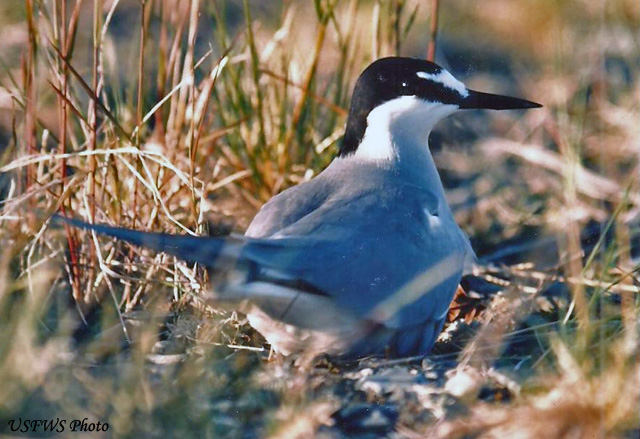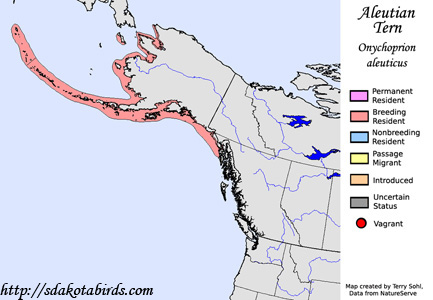| Length: 12 inches | Wingspan: 28 inches | Seasonality: Non-resident in South Dakota |
| ID Keys: Black cap and nape with white forehead (breeding plumage), thin black bill, black legs. Non-breeding birds lose the dark cap. | ||
 The
Aleutian Tern is a less common companion to the
Arctic Tern, often found in close
association with the Arctic Tern, but typically in much smaller numbers.
They are relatively poorly studied, and the wintering range of the species
was completely unknown until the 1980s, when some birds were found
overwintering in the oceans near Indonesia. Total populations are relatively
small, but given their normal range, there are no serious threats to the
species at this time.
The
Aleutian Tern is a less common companion to the
Arctic Tern, often found in close
association with the Arctic Tern, but typically in much smaller numbers.
They are relatively poorly studied, and the wintering range of the species
was completely unknown until the 1980s, when some birds were found
overwintering in the oceans near Indonesia. Total populations are relatively
small, but given their normal range, there are no serious threats to the
species at this time.
Habitat: Outside of the breeding season, Aleutian Terns are pelagic, often found in the open ocean very far from shore. During the summer breeding season, they are found on islands and coastlines of western Alaska, in areas with vegetative cover for nesting sites.
Diet: Feeds on small crustaceans such as euphausiid shrimp, as well as small fish, insects, and other small invertebrates.
Behavior: Foraging is done by flying low over the water's surface, with birds dipping down to the water to grab food items when they see them. Unlike many other tern species, they are not known to plunge-dive for food.
Nesting: The nest of an Aleutian Tern is a depression on the ground, placed amongst vegetation that is close to water. The female lays 1 or 2 eggs, and both parents help to incubate them. When the eggs hatch, both parents feed the young. The young fledge after about one month.
Interactive eBird Map: Click to access an interactive eBird map of Aleutian Tern sightings.
Song: The most common call is a soft descending whistle
Migration: A long distance migrant, with most birds evidently nesting in the south Pacific, in areas near Indonesia. Summer breeding grounds restricted to western Alaska and the Aleutians in North America, although some birds also nest in eastern Russia.
Similar Species: Similar to the Arctic Tern
Conservation Status: Populations are not very large, but they are considered stable. The IUCN lists the Aleutian Tern as a species of "Least Concern".
Further Information: 1) Audubon.org - Aleutian Tern
2) Alaska Seabird Information Series - Aleutian Tern
3) BirdLife International - Aleutian Tern
Photo Information: Photo is U.S. Fish and Wildlife Photo licensed under Creative Commons Attribution NonCommercial NoDerivs 2.0 Generic License
| Click below for a higher-resolution map |
 |
| South Dakota Status: Non-resident in South Dakota |
Additional Aleutian Tern Photos (coming soon!!)
